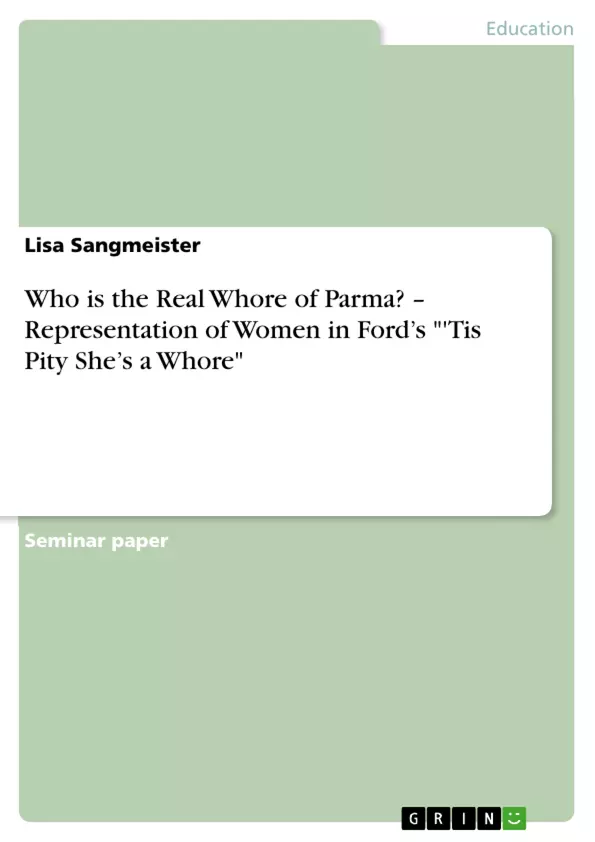Not only because of its provoking title, ‘Tis Pity She’s a Whore can be described as John Ford’s most controversial play (Anderson 92). The play’s main plot portrays the passionate but forbidden love between the siblings Giovanni and Annabella. Moreover, ‘Tis Pity is an extraordinary violent play with “… several vivid action sequences” (Abate 94). All in all, there are five murder victims, Annabella’s tutress Putana is blinded, and her father Florio drops dead. The play reaches its brutal climax when Giovanni enters the feast with Annabella’s heart on his dagger. Nonetheless, the Cardinal does only blame one person for what has happened in the course of the play: “Of one so young, so rich in Nature’s store, | Who could not say, ‘Tis Pity she’s a whore?” (V.vi.158-159). The Cardinal’s final condemnation seems to be “… unnecessarily vindictive” (Hopkins ix) because Annabella has not only repented of her sins, but she was also killed by her brother and her heart was displayed on his dagger. Besides, Corinne S. Abate points out that there are several other characters “… who could claim this denunciation and our pity” (Abate 94).
Table of Contents
- Introduction
- The Relevance of the Play's Title
- Analysis of the Last Scene
- Analysis of the Title
- Representation of Women
- Women in Jacobean Tragedies
- Women in 'Tis Pity She's a Whore
- Annabella - The Whore of the Play?
- The Role of Society
- Conclusion
Objectives and Key Themes
This paper aims to analyze the controversial title of John Ford's play "Tis Pity She's a Whore," exploring its significance and impact on the play's reception. It examines the representation of women in the play, particularly focusing on the character of Annabella, and explores the role of society in shaping the play's themes.
- The significance of the play's title and its connection to the plot.
- The portrayal of female characters in Jacobean drama and in "Tis Pity She's a Whore" specifically.
- The question of whether Annabella is truly the "whore" of the play.
- The role of society in shaping the characters' actions and the play's overall themes.
- The controversial nature of the play and its exploration of themes of incest, murder, and moral ambiguity.
Chapter Summaries
- Introduction: Introduces the play "Tis Pity She's a Whore" as one of John Ford's most controversial works, highlighting its themes of incest, violence, and moral ambiguity. It emphasizes the play's brutal climax and the Cardinal's final condemnation of Annabella, raising questions about the play's title and the representation of women.
- The Relevance of the Play's Title: Analyzes the play's last scene and its final line, "Tis Pity She's a Whore," emphasizing the connection between the title and the play's plot. It explores the meaning of the phrase and its implications for the play's reception.
- Analysis of the Last Scene: Provides a detailed account of the play's final scene, focusing on the Cardinal's judgment and the various characters' roles in the incestuous relationship. This chapter analyzes the Cardinal's condemnation of Annabella and raises questions about the justice of his judgment.
- Representation of Women: Examines the portrayal of women in Jacobean tragedies and in "Tis Pity She's a Whore," highlighting the common tropes and conventions of the time. It specifically focuses on the character of Annabella and explores why she is labeled as the "whore" of the play.
Keywords
This preview focuses on the representation of women in John Ford's "Tis Pity She's a Whore," analyzing the play's title, its final scene, and the portrayal of female characters in Jacobean drama. Key themes include incest, murder, moral ambiguity, and the question of whether Annabella is truly the "whore" of the play. The preview also explores the role of society in shaping the play's themes and characters.
- Arbeit zitieren
- Lisa Sangmeister (Autor:in), 2010, Who is the Real Whore of Parma? – Representation of Women in Ford’s "'Tis Pity She’s a Whore", München, GRIN Verlag, https://www.grin.com/document/166095



